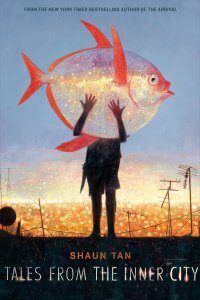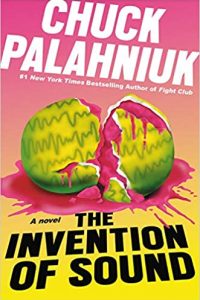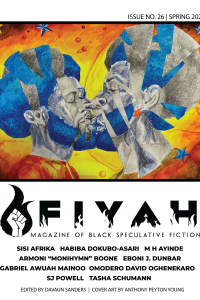Karen Haber Reviews Tales from the Inner City and Cicada by Shaun Tan
 Tales from the Inner City, Shaun Tan (Arthur A. Levine 978-1338298406, $29.99, 224pp, hc) September 2018. Cover by Shaun Tan.
Tales from the Inner City, Shaun Tan (Arthur A. Levine 978-1338298406, $29.99, 224pp, hc) September 2018. Cover by Shaun Tan.
Cicada, Shaun Tan (Arthur A. Levine Books 9-781-338-29839-0, $19.99, unpaginated, tp) June 2018. Cover by Shaun Tan.
It’s always exciting to open a new book by Shaun Tan – you never know what you’ll see. Recipient of many awards, including an Academy Award for the animated film The Lost Thing, Tan is an artistic polymath: he writes, draws, paints, sculpts, animates, and is comfortable telling stories by word or image, in wordless panels, children’s storybooks, text, and image-filled story collections.
His work transcends genre: despite its frequently fantastic settings and situations, the emotions that Tan portrays are universally human, even when the vehicle for them is a giant bug wearing a business suit. His productivity could intimidate other artists. Three new publications reviewed in this column demonstrate his versatility. His vision is at once down-to-earth, profound, whimsical, and, often, humorous. Tan makes universal emotions tangible across cultures, species, and various storytelling formats.
He is also, quietly, a political artist, striking from the heart against the soul-deadening forces of conformity in modern urban life, the waste-laying exploitative activities of the dehumanizing corporate world. His work can be read as muted protest against the cruelty and destructive tendencies of industrialized culture in which the outlier is always potentially at risk. These concerns underlie his work in such books as Tales from Outer Suburbia (2008), The Lost Thing (2010), and his newest book, Tales from the Inner City, a sister volume to Tales from Outer Suburbia.
This new collection of 25 illustrated fantasy stories focuses on relationships between humans and animals in urban settings. It is a handsome book whose colorful cover hints at exotic and remarkable contents. Arthur A. Levine, Tan’s US publisher, consistently produces high-quality volumes of Tan’s work, with thick, creamy paper, sewn-in binding, and excellent color reproduction.
In his new book, Tan plays with format as well as image, providing a two-page spread of numbered animal silhouettes that functions as a table of contents. The illustrations for each story vary in number and treatment, while the storytelling is similarly varied in free verse, ruminations, and self-contained vignettes.
Among the tales Tan spins is one recommending the soul-restoring pleasures of commuting by yak. There are bears with lawyers, tigers loose in the city, owls as comfort animals in hospitals. In the end, the evil corporations are no match for nature. Again and again, the touchstone of these stories is the life-affirming interaction with the natural world, even if it’s only in dreams.
The heart of the book provides a free-verse consideration on the deep connection between humans and canines, from the original primal acceptance to the deep emotional attachments of modern day. Tan offers several moving illustrations as variations on this theme, showing various dogs separated from their humans by a wide expanse varying in geography, color, and texture, implying loss, possibly, death. The body language of each human suggests grief over the separation. Meanwhile, each faithful animal waits for its human to cross over the great divide. The text promises a reunion of sorts, and eventually the illustrations fulfill that promise.
In Tales from the Inner City, Tan spends time with themes that have informed his other work: the relationship of animals and people, loneliness and alienation, the inhumanity of the corporate state – and how the love of an animal, the kindness of a stranger, some sort of emotional connection – can make a profound difference across boundaries, perhaps even across time. In both text and paintings, in a variety of styles, he makes a magical connection with the reader. In Tales from The Inner City, this gifted artist shares – and allows us to temporarily transcend – the challenges and pain of being human.
Tan’s mastery of the children’s book format has been recognized by the Astrid Lindgren prize (2011) for children’s literature. In Cicada, he displays his considerable skill in a melancholic-yet-hopeful children’s book which adults will also enjoy.
The humorous illustrations tell the tale of a giant cicada who works hard but just can’t fit in with a big corporate workforce and stoically suffers bullying, rejection, and insult until, just when we fear the worst, he magically transcends it all and escapes. Despite its seeming simplicity, this book offers a profound message of hope that should resonate across generations of readers.
Along the way, we can enjoy the surreal images of a big bug putting on his shirt and tie and trying, without success, to fit into the enforced homogeneity of an urban business environment. Especially telling is an illustration showing the cicada’s head as seen from above a maze of cubicles, in which he not only resembles a modern corporate worker but also evokes a subject trapped in a laboratory test. The colors Tan employs here are emotionally and psychologically significant, reminiscent of The Red Tree (2001), in which subdued colors ultimately give way to a bright splash of joy.
This review and more like it in the March 2019 issue of Locus.
 While you are here, please take a moment to support Locus with a one-time or recurring donation. We rely on reader donations to keep the magazine and site going, and would like to keep the site paywall free, but WE NEED YOUR FINANCIAL SUPPORT to continue quality coverage of the science fiction and fantasy field.
While you are here, please take a moment to support Locus with a one-time or recurring donation. We rely on reader donations to keep the magazine and site going, and would like to keep the site paywall free, but WE NEED YOUR FINANCIAL SUPPORT to continue quality coverage of the science fiction and fantasy field.







